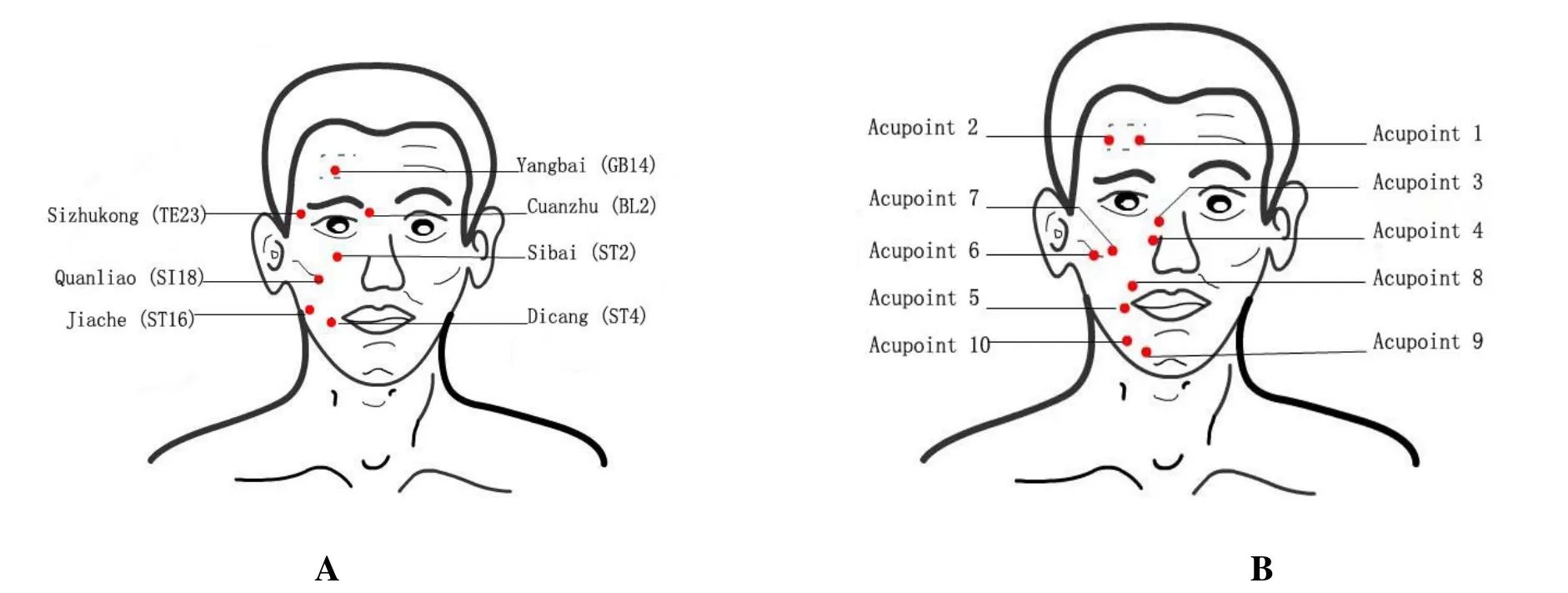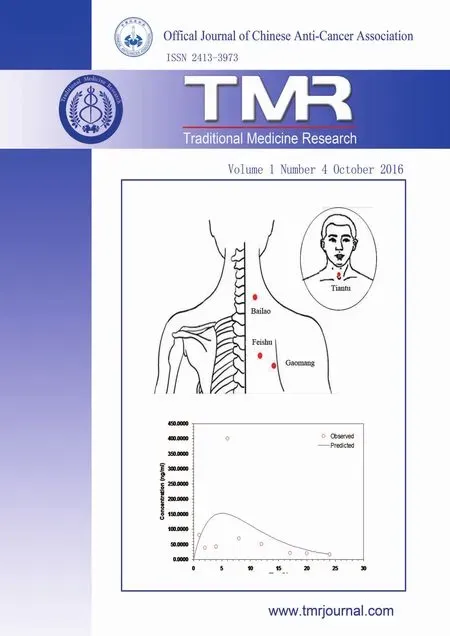A new idea of electro-acupuncturetreatment for peripheral facial paralysis and thenerve-endocrinehypothesis
2016-09-14ChaoYongWuGuangFuWuXinYuWang
Chao-Yong Wu,Guang-Fu Wu,Xin-Yu Wang
1Beijing University of Chinese Medicine,Beijing,China.2The General Hospital of the People's Liberation Army,Beijing,China.
1.Introduction
Peripheral facial paralysis(PFP)is a common disease with a high incidence,the onset of which is the result of edema of facial nerves and myelin sheath.PFP is characterized by disappearance of frontal stripes to varying degrees on the affected side,weakness in knitting the brows,failure of eyelid closure,unable to shrug the nose,the nasolabial groove becoming shallow,the nasolabial groove and the lip slanting towards the healthy side,corner of the mouth on the affected side decreasing,the food retaining in the mouth cheek[1].At present,western medicine mainly adopts medication and operation therapy.Cortical hormone treatment,anti-virus treatment,angiectasis therapy, vitamin treatment, massage, functional training and facial nerve decompression,facial nerve anastomosis and face-lifting operation,and so on are often used.However,restoration of facial nerve and facial muscle function is not ideal,and there are some serioussequelae.
Traditional acupuncture describe the symptoms of PFPwith“deviated mouth” (kouwai,口歪/口喎;koupi,口僻;waizuifeng,歪嘴风,etc.words).According to traditional Chinese medicine,the causes of PFPare invasion of exogenous pathogenic wind and cold,associated with internal pathogenic factors(emotions).So PFP should be treated through dispelling wind and removing obstruction in the meridians and regulating the muscle region.Acupuncture therapy has been used widely for the treatment of PFPin China and throughout the world.It believes that the pathogenic location of PFP were meridiansand muscle regionsof the Stomach Meridian of Foot-Yangming and Small Intestine Meridian of Hand-Taiyang.The main points include Cuanzhu(BL 2),Sizhukong(TE 23),Yangbai(GB 14),Sibai(ST 2),Quanliao(SI 8),Jiache(ST 6),Dicang(ST 4),Hegu(LI 4),Taichong(LR 3).And choose Yuyao(EX 3),Shenmai(BL 62),Yingxiang(LI 20),Chengjiang(CV 24),Fengchi(GB 20),Fengfu(GV 16),Yifeng(TE 17)depending on syndrome differentiation.(As shown in Figure1A)
Acupuncture treatment of this disease has a long history and clinical practice.However,its effectiveness is still under debate from Cochrane reviews and meta-analyses[2,3].Except for some defects in the protocol design and implementation, different manipulations among Chinese and foreign physicians are very important reasons for the conflicting opinions.Hence,It is necessary to explore a scientific and repeatable treatment strategy,which should be effective,simple,safe and easy to master and promote.In the thesis,a new idea of electro-acupuncture treatment for PFPand mechanisms behind therapeutic acupuncture were put forward.
2.A new idea of the EA treatment of PFP
2.1Acupointsselection and manipulation of PFP
According to the distribution of facial nerve and its dominant muscles,10 acupoints were selected(Figure 1B)[4].Prefrontal area:Acupoint 1,move inward 0.5cm horizontally from Yangbai(GB 14).Acupoint 2,the medial point on the line linking Xuanlu(GB 5)and Sizhukong(TE 23).Cheek area:Acupoint 3,the same position as Shangyingxiang(EX 5).Acupoint 4,move outward 0.5cm horizontally from Yingxiang(LI 20).(Level with Yingxiang(LI 20)and move outward 0.5cm.)(0.5cm lateral to Yingxiang(LI 20)).Acupoint 5,move outward 2mm horizontally from Dicang(ST 4).Acupoint 6,move outward 0.5cm horizontally from Quanliao(SI 8).Acupoint 7,move outward 0.5cm horizontally from Juliao(ST 3).Acupoint 8,the medial point on the line linking acupoint 4 and acupoint 5.Mandibular area:acupoint 9 and acupoint 10.Draw vertical lines from the corner of the mouth and outer canthus,and draw a curve level with the Mandibular margin from 1cm below the corner of the mouth.The two connecting pointsaretheacupoints.

Figure1:the acupoint selection of traditional acupunctureand thenew idea of electro-acupuncture
Operation requirement:After routine disinfection,choose 25mm long filiform needle,for the acupoint 1 and acupoint 2,obliquely puncture towards the eyepit.For the other acupoints,puncture straightly and without acupuncture manipulation.Then connect to the discontinuous wave and fine-tune the depth and direction of needling according to the electrical responses of muscle.These five groups include acupoint 1 and acupoint 2,acupoint 3 and acupoint 4,acupoint 5 and acupoint 6,acupoint 7 and acupoint 8,acupoint 9 and acupoint 10,covering five major areas of facial nerve.After power on,we can see the tonic contraction in the corresponding muscle.This treatment prescription is about 20-30 minutes each time,onceaday.
2.2 Reaction and effect after acupuncture
The first EA group,Acupoint 1 and 2,improves shallow or disappeared forehead wrinkles and dysfunction of eyelid closure,by stimulating the frontal belly of occipitofrontal muscle and the orbital part of the orbicularis oculi.The second EA group,Acupoint 3 and 4,improves weakness of eyebrow,inability of the nose and dysfunction of the superficial or disappearance of the nasal groove by stimulating procerus,nasal muscle and upper lip nasal muscle.The third and fourth EA group,acupoint 5 and 6,acupoint 7and 8,improves the bared teeth weakness,drooping mouth,chewing and sucking weakness dysfunction.The muscles involved include the superficial zygomaticus major muscle and zygomaticus minor muscle,the medial levator anguli oris and the deeper buccinator muscle.The fifth EA group,acupoint 9 and 10,improvesdistortion of commissure and growling or pouting weakness by stimulating depressor labii inferioris muscle and mentalis muscle.The above 5 groups of acupoints cover the main expression area which are controlled by the facial nerve.On the one hand,it can maximally excite the paralyzed musclesby independent,and target stimulation on the large muscle groups innervated by the facial nerve.On the other hand,the interaction between different muscles can be reduced to aminimum.
But it needs to be explained that PFPnot necessarily involves the whole range of clinical manifestations.So carefully check the functional status of the facial muscles before treatment,and mainly treat the functional-impaired muscles.The depth of needle insertion,the shape of the patient's skull,the thickness of the facial expression muscles,all have an impact on the electrical response,directly affect the efficacy.The puncture site,the number of acupoints,the energized size and other treatment factors can be adjusted according to clinical practice.Strong stimulation is not suitable,the patient should speak less,do less expression,have more rest,take shelter from the wind cold,and warm compress,during the acute phase(within 7 days).It is encouraged to softly nudge the musclesalong thedirection of theinjured facial muscle fiber or along thedirection of facial musclecontraction,several times a day and each time about 10 minutes.But do not hard press,or massagewith force.
3.The Nerve-Endocrine Hypothesis of EA treatment of PFP
F wave,based on the physiological integrity of motor neurons,can check the disturbance of the nerve conduction pathway,including the intracranial part of facial nerve.The mechanism of F wave is based on bidirectional conductivity of nerve conduction.If a supraliminal stimulation is applied to the motor nerve,the excitability will be conducted along the direction of both ends of the central(retrograde)and the muscle(forward)at the same time.Fwave is a small potential evoked by a few motor neurons in the anterior horn of the spinal cord(or the motor nucleus of the brainstem).These motor neurons produce excitability again after receiving the retrograde conduction stimulation.The excitability will move forward again along the motor axons to the muscles and produce the small potential.So the afferent and efferent nerves of F wave are the same motor nerve. It is very suitable for mainly-motor-functional facial nerve from the mechanism perspective [5].So the EA clinical treatment of PFPis totally scientific and possible.The main effect of this treatment is to improve the nerve conduction disturbance by applying a supraliminal stimulation to peripheral motor nerve,waiting the forward conduction of F wave and adjusting the current intensity.
Experimental studies have shown that electrical nerve stimulation can shorten the repair time of damaged axons[6]and transcutaneous electrical nerve stimulation can significantly improve symptoms of facial nerve injury[7].Brief electrical stimulation enhances the regenerative ability of axotomized motor and the numbers of neurons,with a significant increase in expression of growth-associated protein 43(GAP-43)mRNA and brain-derived neurotrophic factor(BDNF)[8].Acupuncture associated with electrical stimulation reversed the peripheral facial paralysis in a short time.Severe sequelae were minimized due to the balance of muscle activation in response to the electrical stimulation provided by the acupuncture needles[9].Domestic researches have confirmed that EA can promote regeneration of peripheral nerve and have a significant effect on PFP and the effect is better than other acupuncture therapies[10-11].The electrical stimulation in acute phase can produce the following effects:enhance the phagocytic capacity of white blood cells,increase the number of red blood cells,enhance anti-inflammatory effect, improve the nutritional status of damaged nerves,promote the absorption of inflammatory edema, shorten compression time of the facial nerve,increase the recovery rate of PFP[12].The recent intensive study of JAK1-STAT3 signaling pathway has shown that EA plays a good role in promoting the repair of damaged facial nerve through JAK1-STAT3 signaling pathway which mediated by CNTFR[13].Based on the existing related research results,we speculate that the good therapeutic effect of EA on PFPmay be based on the nerveendocrinesystem.
4.Discussion
It is recognized that prednisolone but not antiviral medicine shows significant short-term and long-term positive treatment effects in patients with PFP.This treatment should be used routinely for patients with PFP.It is noticed in clinics that acupuncture therapy alone also can achieve significant curative effect without prednisolonefor patientswith PFP.
There are more than ten kinds of acupuncture treatment for PFP,including filiform-needle therapy,EA and rad-hot needle therapy etc.And all of them are effective in their clinical reports[14-17].Guo Dongjie[18]indexed 62 ancient books of acupuncture and moxibustion from the Huangdi's Internal Classics to the end of the Qing dynasty by computer.Statistical results showed that the ancient acupuncture treatment of PFP involved 81 acupoints,266 acupoint-times,mainly for the Yangming meridians acupoints and Foot-Taiyang acupoints as a supplement.In the long history of clinical practice,physicians had a further understanding of the disease,accumulated and created new theories and treatment methods.However,its effectiveness is still under debate[19,20]because of different manipulations among Chinese and foreign physicians.
Based on the principleof evidence-based medicine,it’s necessary to explore an effective therapy,which should be effective,simple,safe and easy to master and promote.Based on thousands of clinical cases of facial paralysis patients from past decades,Professor Wang summarized the above therapy and put forward the “Nerve-Endocrine Hypothesis”.But the hypothesis of thisstudy is not complete with fundamental research and experiments,further work isunderway.
Reference
1.Li Y,Wu X,Hu KM,et al.Current Situation and Evaluation of Clinical Studies on Acupuncture and Moxibustion Treatment of Peripheral Facial Paralysis at Selected Stages.J Tradit Chin Med 2010,30(2):153-159.
2.He L,Zhou MK,Zhou D,et al.Acupuncture for Bell’s palsy.Cochrane Database Syst Rev 2007,4:CD002914.
3.Chen N,Zhou M,He L,et al.Acupuncture for Bell’s palsy.Cochrane Database Syst Rev 2010,8:CD002914.
4.Wang XY,Jiang YB.A further discussion on acupuncture treatment plan of facial neuritis in Evidence-based Guidelines of clinical Practice in Acupuncture and Moxibustion.Chin Acupunct Moxibustion 2014,34(6):602-604.
5.Chi RF.Facial nerve diseases.Shanghai:Shanghai scienceand Technology Publishing House 2007,6:226-243.
6.Sharma N,Marzo SJ,Jones KJ,et al.Electrical stimulation and testosterone differentially enhance experience of regeneration-associated genes.Exp Neurol 2010,223(1):183-191.
7.Hyvarinen A,Tarka IM,Meraala E,et al.Cutaneous electrical stimulation treatment in resolved facial nerve paralysis:an exploratory study Am J Phys Med Rehabil,2008,87(12):992-997.
8.Geremia NM,Gordon T,Brushart TM,et al.Electrical stimulation promotes sensory neuron regeneration and growth-associated gene expression.Exp Neurol 2007,205(2):347-359.
9.Fabrin S,Soares N,Regalo SC,et al.The Effects of Acupuncture on Peripheral Facial Palsy Sequelae after 20 Years via Electromyography.J Acupunct Meridian Stud 2015,8(5):245-248.
10.Du X. Study on the influence of electroacupuncture on the nerve growth guidance factors of peripheral nerve injured rats.Chengdu Univery Tradit Chin Med,2012.
11.Liu LA,Zhu ZB,Qi QH,et al.Comparison of therapeutic effects of peripheral facial paralysis in acute stage by different interventions.Chin Acupunct Moxibustion 2010,30(12):989-992.
12.Zhang WA.Study of electroacupuncture on Schwann cell morphology and CNTF expression in facial nerve injury.Chengdu: Chengdu University of Traditional Chinese Medicine,2012.
13.Sun YH.Mechanism of JAK1-STAT3 signal transduction in Electro-Acupuncture for treating facial nerve injured. Chengdu: Chengdu University of Traditional Chinese Medicine,2012.
14.Li Y,Li Y,Liu LA,et al.Acupuncture and moxibustion for peripheral facial palsy at different stages:multi-central large-sample randomized controlled trial.Chin Acupunct Moxibustion 2011,31(4):289-293.
15.An HJ.Combined acupuncture and medicine in the treatment of 43 cases of acute peripheral facial paralysis.Henan Tradit Chin Med 2014,34(9):9.
16.Wu JY,Liu XX,Wu MD.Electroacupuncture in the treatment of 100 cases of acute facial paralysis.JClin Acupunct and Moxibustion 2004,20(8):35.
17.Song XW,Zhao QC,Xie XC.Clinical observation on treatment of 56 cases of peripheral facial paralysis with Acupuncture.Beijing tradit Chin Med 2007,26(2):98-100.
18.Guo DJ,Gu J,Liu LG.Analysis the characteristics of acupuncture therapy for facial paralysis in ancient scripts.Chin Acupunct Moxibustion 1999,19(4):245.
19.Singh S,Ernst E.Thetruth about acupuncture,in trick or treatment.New York:W.W.Norton Company,2008:39-88.
20.Haake M,Müller HH,Schade-Brittinger C,et al.German Acupuncture Trials(GERAC)for chronic low back pain:randomized,multicenter,blinded,parallel-group trial with 3 groups.Arch Intern Med 2007,167(17):1892-1898.
杂志排行
Traditional Medicine Research的其它文章
- Dynamic changesof circulating Th1 and Th17 cellsin psoriasispatients:a report of 3 cases treated by Chineseherbal medicine
- Pharmacokinetic study of dl-tetrahydropalmatinepatchesby UPLC–MS/MSin rabbits
- A prospective,randomized controlled trial of sanguisorba oil in the treatment of tamoxifen-related vaginitisin breast cancer patients
- A Literature Review of the Acupoint Plaster Therapy for Asthma in Summer
- Effectsof acupuncture treatment for irritablebowel syndrome:a systematic review and meta-analysis
- Challengesand opportunitiesof applying P4 medicineand traditional Chinese medicinefor cancer treatment and prevention in the21st century:A medical oncologist’sperspectives
